Total Ozone Trends in East Asia from Long-Term Satellite and Ground Observations
Abstract
1. Introduction
2. Materials and Methods
2.1. Satellite Composite Data
2.2. Ground Observation Data
2.3. Multi-Linear Regression
3. Results and Discussion
3.1. Characteristics of Ozone Trends in East Asia
3.2. Atmospheric Proxies
3.3. Recent Trend in East Asia
4. Conclusions
Author Contributions
Funding
Data Availability Statement
Acknowledgments
Conflicts of Interest
References
- Ko, M.K.W.; Newman, P.A.; Reimann, S. ; Lifetimes of Stratospheric Ozone-Depleting Substances, Their Replacements, and Related Species, World Climate Research Programme; SPARC: Devens, MA, USA, 2013; Avaliable online: https://www.sparc-climate.org/fileadmin/customer/6_Publications/SPARC_reports_PDF/6_SPARC_LifetimeReport_Web.pdf (accessed on 28 July 2021).
- World Meteorological Organization (WMO). Scientific Assessment of Ozone Depletion: 2018, Global Ozone Research and Monitoring Project—Report No. 58; World Meteorological Organization (WMO): Geneva, Switzerland, 2018. [Google Scholar]
- SPARC/IO3C/GAW Report on Long-term Ozone Trends and Uncertainties in the Stratosphere; SPARC: Devens, MA, USA, 2019; Available online: www.sparc-climate.org/publications/sparc-reports (accessed on 28 July 2021).
- Weber, M.; Coldewey-Egbers, M.; Fioletov, V.E.; Frith, S.M.; Wild, J.D.; Burrows, J.P.; Long, C.S.; Loyola, D. Total ozone trends from 1979 to 2016 derived from five merged observational datasets—The emergence into ozone recovery. Atmos. Chem. Phys. 2018, 18, 2097–2117. [Google Scholar] [CrossRef]
- Zerefos, C.; Kapsomenakis, J.; Eleftheratos, K.; Tourpali, K.; Petropavlovskikh, I.; Hubert, D.; Godin-Beekmann, S.; Steinbrecht, W.; Frith, S.; Sofieva, V.; et al. Representativeness of single lidar stations for zonally averaged ozone profiles, their trends and attribution to proxies. Atmos. Chem. Phys. 2018, 18, 6427–6440. [Google Scholar] [CrossRef]
- Dyominov, I.G.; Zadorozhny, A.M. Greenhouse gases and recovery of the Earth’s ozone layer. Adv. Space Res. 2005, 35, 1369–1374. [Google Scholar] [CrossRef]
- Chipperfield, M.; Bekki, S.; Dhomse, S.; Harris, N.; Hassler, B.; Hossaini, R.; Steinbrecht, W.; Thieblemont, R.; Weber, M. Detecting recovery of the stratospheric ozone layer. Nature 2017, 549, 211–218. [Google Scholar] [CrossRef] [PubMed]
- Banerjee, A.; Maycock, A.C.; Archibald, A.T.; Abraham, N.L.; Telford, P.; Braesicke, P.; Pyle, J.A. Drivers of changes in stratospheric and tropospheric ozone between year 2000 and 2100. Atmos. Chem. Phys. 2016, 16, 2727–2746. [Google Scholar] [CrossRef]
- Molina, M.; Rowland, F. Stratospheric sink for chlorofluoromethanes: Chlorine atom-catalysed destruction of ozone. Nature 1974, 249, 810–812. [Google Scholar] [CrossRef]
- Stolarski, R.S.; Cicerone, R.J. Stratospheric chlorine: A possible sink for ozone. Can. J. Chem. 1974, 52, 1610–1615. [Google Scholar] [CrossRef]
- Haigh, J.D.; Pyle, J.A. Ozone perturbation experiments in a two-dimensional circulation model. Q. J. R. Meteorol. Soc. 1982, 108, 551–574. [Google Scholar] [CrossRef]
- Jonsson, A.I.; Fomichev, V.I.; Shepherd, T.G. The effect of nonlinearity in CO2 heating rates on the attribution of stratospheric ozone and temperature changes. Atmos. Chem. Phys. 2009, 9, 8447–8452. [Google Scholar] [CrossRef]
- Collins, W.J.; Derwent, R.G.; Garnier, B.; Johnson, C.E.; Sanderson, M.G. Effect of stratosphere-troposphere exchange on the future tropospheric ozone trend. J. Geophys. Res. 2003, 108. [Google Scholar] [CrossRef]
- Hwang, S.-H.; Kim, J.; Cho, G.-R. Observation of secondary ozone peaks near the tropopause over the Korean peninsula associated with stratosphere-troposphere exchange. J. Geophys. Res. 2007, 112. [Google Scholar] [CrossRef]
- Hegglin, M.; Shepherd, T. Large climate-induced changes in ultraviolet index and stratosphere-to-troposphere ozone flux. Nat. Geosci. 2009, 2, 687–691. [Google Scholar] [CrossRef]
- Park, S.S.; Kim, J.; Cho, H.K.; Lee, H.; Lee, Y.; Miyagawa, K. Sudden increase in the total ozone density due to secondary ozone peaks and its effect on total ozone trends over Korea. Atmos. Environ. 2012, 47, 226–235. [Google Scholar] [CrossRef]
- Newman, P.A.; Daniel, J.S.; Waugh, D.W.; Nash, E.R. A new formulation of equivalent effective stratospheric chlorine (EESC). Atmos. Chem. Phys. 2007, 7, 4537–4552. [Google Scholar] [CrossRef]
- Randel, W.J.; Wu, F.A. Stratospheric ozone profile data set for 1979–2005: Variability, trends, and comparisons with column ozone data. J. Geophys. Res. Atmos. 2007, 112, D06313. [Google Scholar] [CrossRef]
- World Meteorological Organization (WMO). Scientific Assessment of Ozone Depletion: 2014, Global Ozone Research and Monitoring Project—Report No. 55; World Meteorological Organization (WMO): Geneva, Switzerland, 2014. [Google Scholar]
- Dhomse, S.S.; Kinnison, D.; Chipperfield, M.P.; Salawitch, R.; Cionni, I.; Hegglin, M.I.; Abraham, N.L.; Akiyoshi, H.; Archibald, A.T.; Bednarz, E.M.; et al. Estimates of ozone return dates from Chemistry—Climate Model Initiative simulations. Atmos. Chem. Phys. Discuss. 2018, 18, 8409–8438. [Google Scholar] [CrossRef]
- Butchart, N. The Brewer-Dobson circulation. Revs. Geophys. 2014, 52, 157–184. [Google Scholar] [CrossRef]
- Flury, T.; Wu, D.L.; Read, W.G. Variability in the speed of the Brewer–Dobson circulation as observed by Aura/MLS. Atmos. Chem. Phys. 2013, 13, 4563–4575. [Google Scholar] [CrossRef]
- Rigby, M.; Park, S.; Saito, T.; Western, L.M.; Redington, A.L.; Fang, X.; Henne, S.; Manning, A.J.; Prinn, R.G.; Dutton, G.S.; et al. Increase in CFC-11 emissions from eastern China based on atmospheric observations. Nature 2019, 569, 546–550. [Google Scholar] [CrossRef] [PubMed]
- Dhomse, S.S.; Feng, W.; Montzka, S.A.; Hossaini, R.; Keeble, J.; Pyle, J.A.; Daniel, J.S.; Chipperfield, M.P. Delay in recovery of the Antarctic ozone hole from unexpected CFC-11 emissions. Nat. Commun. 2019, 10, 5781. [Google Scholar] [CrossRef] [PubMed]
- Montzka, S.A.; Dutton, G.S.; Yu, P.; Ray, E.; Portmann, R.W.; Daniel, J.S.; Kuijpers, D.L.; Hall, B.D.; Mondeel, D.; Siso, C.; et al. An unexpected and persistent increase in global emissions of ozone-depleting CFC. Nature 2018, 557, 413–417. [Google Scholar] [CrossRef] [PubMed]
- Kim, J.; Jeong, U.; Ahn, M.; Kim, J.H.; Park, R.J.; Lee, H.; Song, C.H.; Choi, Y.; Lee, K.; Yoo, J.; et al. New Era of Air Quality Monitoring from Space: Geostationary Environment Monitoring Spectrometer (GEMS). Bull. Am. Meteorol. Soc. 2020, 101, E1–E22. [Google Scholar] [CrossRef]
- Kim, J.; Cho, H.K.; Lee, Y.G.; Oh, S.N.; Baek, S.-K. Updated trends of stratospheric ozone over Seoul. J. Atmos. 2005, 15, 101–118. [Google Scholar]
- Shin, D.; Song, S.; Ryoo, S.-B.; Lee, S.-S. Variations in Ozone Concentration over the Mid-Latitude Region Revealed by Ozonesonde Observations in Pohang, South Korea. Atmosphere 2020, 11, 746. [Google Scholar] [CrossRef]
- McPeters, R.D.; Bhartia, P.K.; Haffner, D.; Labow, G.J.; Flynn, L. The version 8.6 SBUV ozone data record: An overview. J. Geophys. Res. Atmos. 2013, 118, 8032–8039. [Google Scholar] [CrossRef]
- Frith, S.M.; Kramarova, N.A.; Stolarski, R.S.; McPeters, R.D.; Bhartia, P.K.; Labow, G.J. Recent changes in total column ozone based on the SBUV Version 8.6 Merged Ozone Data Set. J. Geophys. Res. Atmos. 2014, 119, 9735–9751. [Google Scholar] [CrossRef]
- DeLand, M.T.; Taylor, S.L.; Huang, L.K.; Fisher, B.L. Calibration of the SBUV version 8.6 ozone data product. Atmos. Meas. Tech. 2012, 5, 2951–2967. [Google Scholar] [CrossRef]
- Bhartia, P.K.; McPeters, R.D.; Flynn, L.E.; Taylor, S.; Kramarova, N.A.; Frith, S.; Fisher, B.; DeLand, M. Solar Backscatter UV (SBUV) total ozone and profile algorithm. Atmos. Meas. Tech. 2013, 6, 2533–2548. [Google Scholar] [CrossRef]
- Kramarova, N.A.; Bhartia, P.; Frith, S.M.; McPeters, R.D.; Stolarski, R.S. Interpreting SBUV smoothing errors: An example using the quasi-biennial oscillation. Atmospheric Meas. Tech. 2013, 6, 2089–2099. [Google Scholar] [CrossRef]
- Kramarova, N.A.; Frith, S.M.; Bhartia, P.; McPeters, R.D.; Taylor, S.L.; Fisher, B.L.; Labow, G.J.; Deland, M.T. Validation of ozone monthly zonal mean profiles obtained from the version 8.6 Solar Backscatter Ultraviolet algorithm. Atmos. Chem. Phys. 2013, 13, 6887–6905. [Google Scholar] [CrossRef]
- TOMS Science Team (Unrealeased). TOMS Earth Probe Total Column Ozone Daily L3 Global 1 deg × 1.25 deg Lat/Lon Grid V008; Goddard Earth Sciences Data and Information Services Center (GES DISC): Greenbelt, MD, USA, 2005; Volume 15, pp. 101–118. Available online: https://disc.gsfc.nasa.gov/datacollection/TOMSEPL3dtoz_008.html (accessed on 12 December 2020).
- Bhartia, P.K. OMI/Aura TOMS-Like Ozone, Aerosol Index, Cloud Radiance Fraction L3 1 Day 1 Degree × 1 Degree V3; NASA Goddard Space Flight Center, Goddard Earth Sciences Data and Information Services Center (GES DISC): Greenbelt, MD, USA, 2012. [Google Scholar] [CrossRef]
- Jaross, G. OMPS-NPP L3 NM Ozone (O3) Total Column 1.0 Deg Grid Daily V2; Goddard Earth Sciences Data and Information Services Center (GES DISC): Greenbelt, MD, USA, 2017. [Google Scholar] [CrossRef]
- Chehade, W.; Weber, M.; Burrows, J.P. Total ozone trends and variability during 1979–2012 from merged datasets of various satellites. Atmos. Chem. Phys. 2014, 14, 7059–7074. [Google Scholar] [CrossRef][Green Version]
- Steinbrecht, W.; Froidevaux, L.; Fuller, R.; Wang, R.; Anderson, J.; Roth, C.; Bourassa, A.; Degenstein, D.; Damadeo, R.; Zawodny, J.; et al. An update on ozone profile trends for the period 2000 to 2016. Atmos. Chem. Phys. 2017, 17, 10675–10690. [Google Scholar] [CrossRef]
- Staehelin, J.; Harris, N.R.P.; Appenzeller, C.; Eberhard, J. Ozone trends: A review. Revs. Geophys. 2001, 39, 231–290. [Google Scholar] [CrossRef]
- Dhomse, S.; Weber, M.; Wohltmann, I.; Rex, M.; Burrows, J.P. On the possible causes of recent increases in northern hemispheric total ozone from a statistical analysis of satellite data from 1979 to 2003. Atmos. Chem. Phys. 2006, 6, 1165–1180. [Google Scholar] [CrossRef]
- Poulain, V.; Bekki, S.; Marchand, M.; Chipperfield, M.P.; Khodri, M.; Lefèvre, F.; Dhomse, S.; Bodeker, G.E.; Toumi, R.; De Maziere, M.; et al. Evaluation of the inter-annual variability of stratospheric chemical composition in chemistry-climate models using ground-based multi species time series. J. Atmos. Sol. Terr. Phys. 2016, 145, 61–84. [Google Scholar] [CrossRef][Green Version]
- Ziemke, J.R.; Chandra, S.; McPeters, R.D.; Newman, P.A. Dynamical proxies of column ozone with applications to global trend models. J. Geophys. Res. 1997, 102, 6117–6129. [Google Scholar] [CrossRef]
- Bodeker, G.; Boyd, I.S.; Matthews, W.A. Trends and variability in vertical ozone and temperature profiles measured by ozonesondes at Lauder, New Zealand: 1986–1996. J. Geophys. Res. Space Phys. 1998, 103, 28661–28681. [Google Scholar] [CrossRef]
- Brunner, D.; Staehelin, J.; Maeder, J.A.; Wohltmann, I.; Bodeker, G.E. Variability and trends in total and vertically resolved stratospheric ozone based on the CATO ozone data set. Atmos. Chem. Phys. 2006, 6, 4985–5008. [Google Scholar] [CrossRef]
- Harris, N.R.P.; Hassler, B.; Tummon, F.; Bodeker, G.E.; Hubert, D.; Petropavlovskikh, I.; Steinbrecht, W.; Anderson, J.; Bhartia, P.K.; Boone, C.D.; et al. Past changes in the vertical distribution of ozone–Part 3: Analysis and interpretation of trends. Atmos. Chem. Phys. 2015, 15, 9965–9982. [Google Scholar] [CrossRef]
- Kuttippurath, J.; Bodeker, G.E.; Roscoe, H.K.; Nair, P.J. A cautionary note on the use of EESC-based regression analysis for ozone trend studies. Geophys. Res. Lett. 2015, 42, 162–168. [Google Scholar] [CrossRef][Green Version]
- Vyushin, D.I.; Shepherd, T.G.; Fioletov, V.E. On the statistical modeling of persistence in total ozone anomalies. J. Geophys. Res. 2010, 115, D16306. [Google Scholar] [CrossRef]
- Lee, H.J.; Jo, H.Y.; Kim, S.W.; Park, M.S.; Kim, C.H. Impacts of atmospheric vertical structures on transboundary aerosol transport from China to South Korea. Sci. Rep. 2019, 9, 13040. [Google Scholar] [CrossRef] [PubMed]
- Lee, S.; Kim, J.; Choi, M.; Hong, J.; Lim, H.; Eck, T.F.; Holben, B.N.; Ahn, J.-Y.; Kim, J.; Koo, J.-H. Analysis of long-range transboundary transport (LRTT) effect on Korean aerosol pollution during the KORUS-AQ campaign. Atmos. Environ. 2019, 204, 53–67. [Google Scholar] [CrossRef]
- Eguchi, K.; Uno, I.; Yumimoto, K.; Takemura, T.; Shimizu, A.; Sugimoto, N.; Liu, Z. Trans-pacific dust transport: Integrated analysis of NASA/CALIPSO and a global aerosol transport model. Atmos. Chem. Phys. 2009, 9, 3137–3145. [Google Scholar] [CrossRef]
- Itahashi, S.; Uno, I.; Kim, S. Seasonal source contributions of tropospheric ozone over East Asia based on CMAQeHDDM. Atmos. Environ. 2013, 70, 204–217. [Google Scholar] [CrossRef]
- Gaikovich, K.P.; Kropotkina, E.P.; Rozanov, S.B. Statistical Analysis of 1996–2017 Ozone Profile Data Obtained by Ground-Based Microwave Radiometry. Remote Sens. 2020, 12, 3374. [Google Scholar] [CrossRef]
- Braesicke, P.; Brühl, C.; Dameris, M.; Deckert, R.; Eyring, V.; Giorgetta, M.A.; Mancini, E.; Manzini, E.; Pitari, G.; Pyle, J.A.; et al. A model intercomparison analysing the link between column ozone and geopotential height anomalies in January. Atmos. Chem. Phys. 2008, 8, 2519–2535. [Google Scholar] [CrossRef]
- Krzyścin, J.W.; Degórska, M.; Rajewska-Więch, B. Impact of interannual meteorological variability on total ozone in northern middle latitudes: A statistical approach. J. Geophys. Res. 2001, 106, 17953–17960. [Google Scholar] [CrossRef][Green Version]
- Li, Y.; Chipperfield, M.P.; Feng, W.; Dhomse, S.S.; Pope, R.J.; Li, F.; Guo, D. Analysis and attribution of total column ozone changes over the Tibetan Plateau during 1979. Atmos. Chem. Phys. 2020, 20, 8627–8639. [Google Scholar] [CrossRef]
- World Meteorological Organization (WMO). WMO Report on The Global Climate in 2015–2019; World Meteorological Organization (WMO): Geneva, Switzerland, 2019. [Google Scholar]
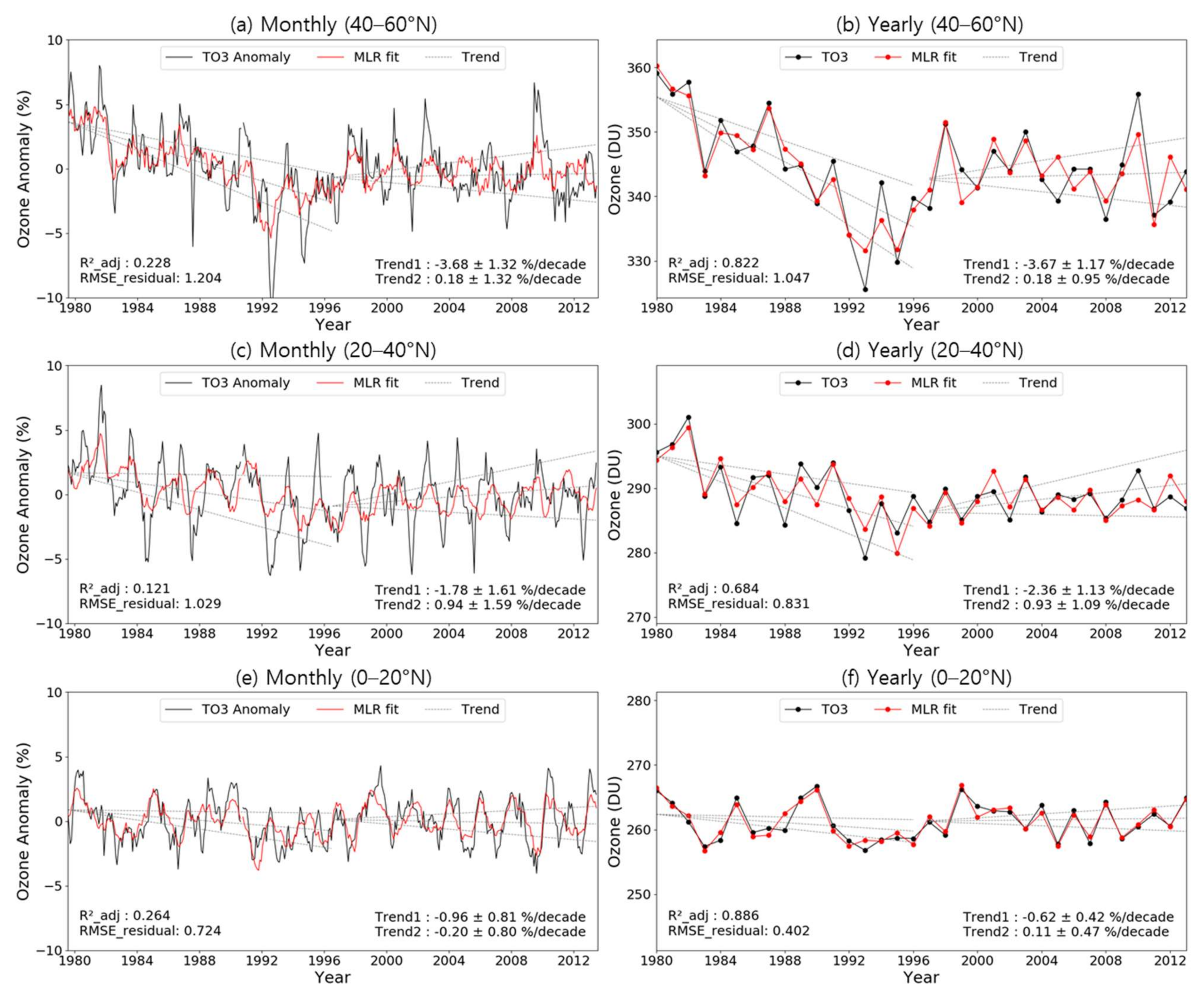
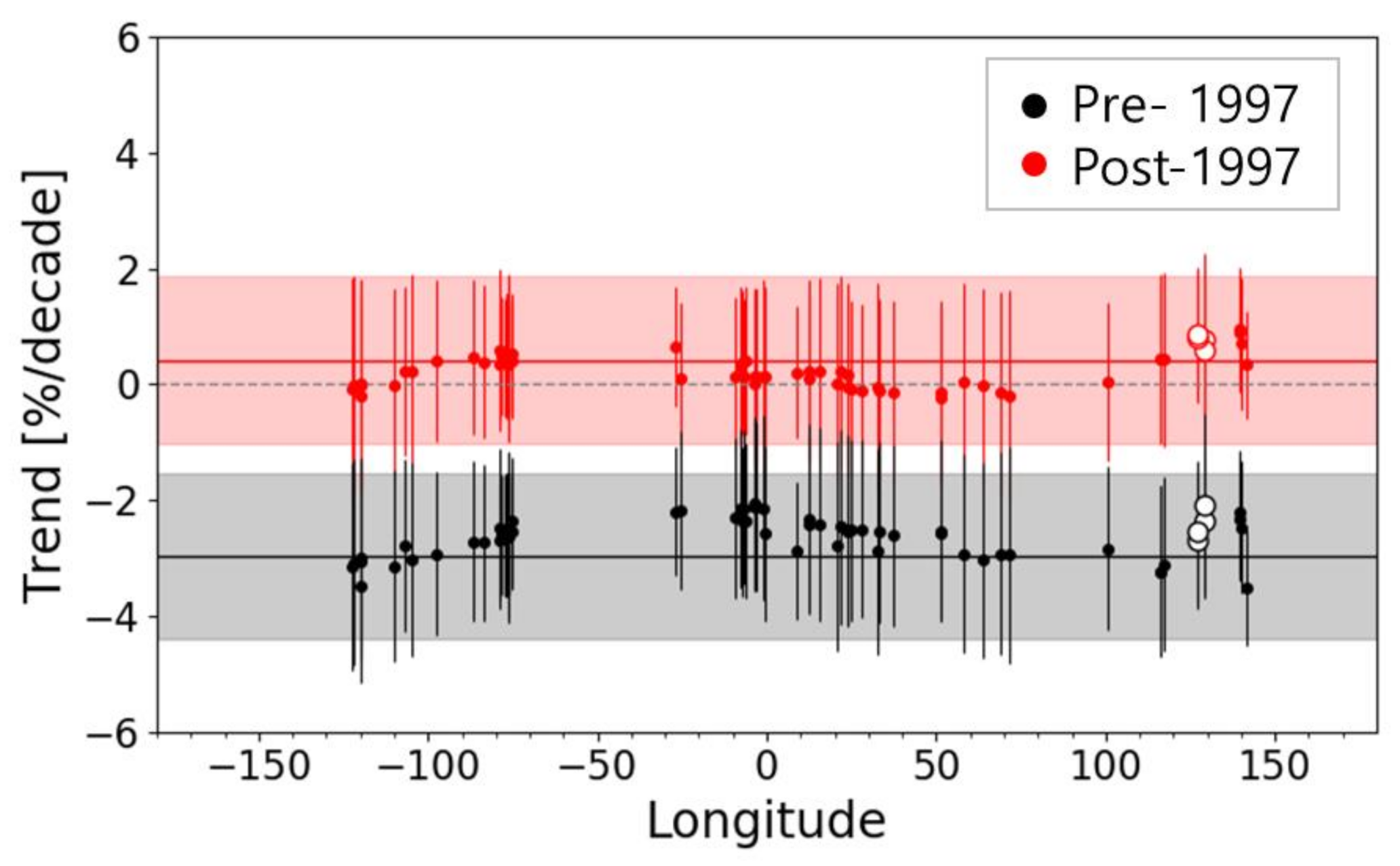
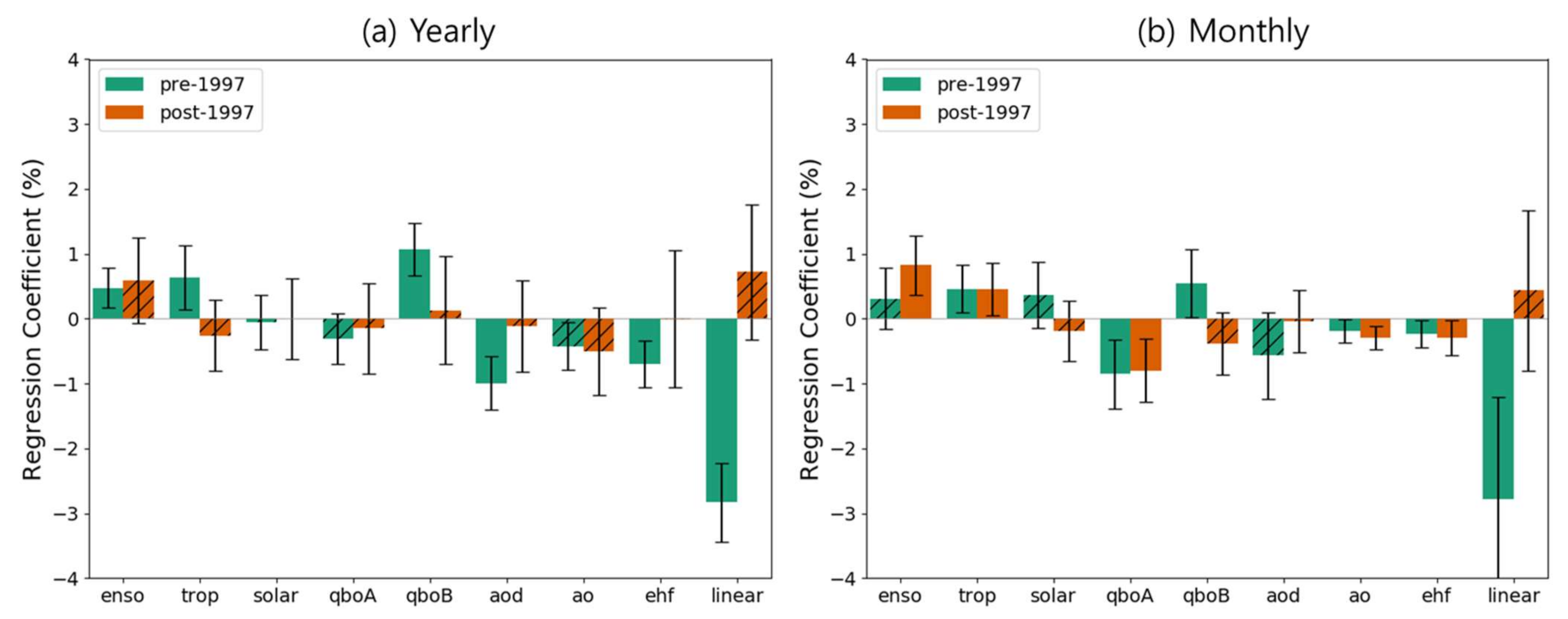

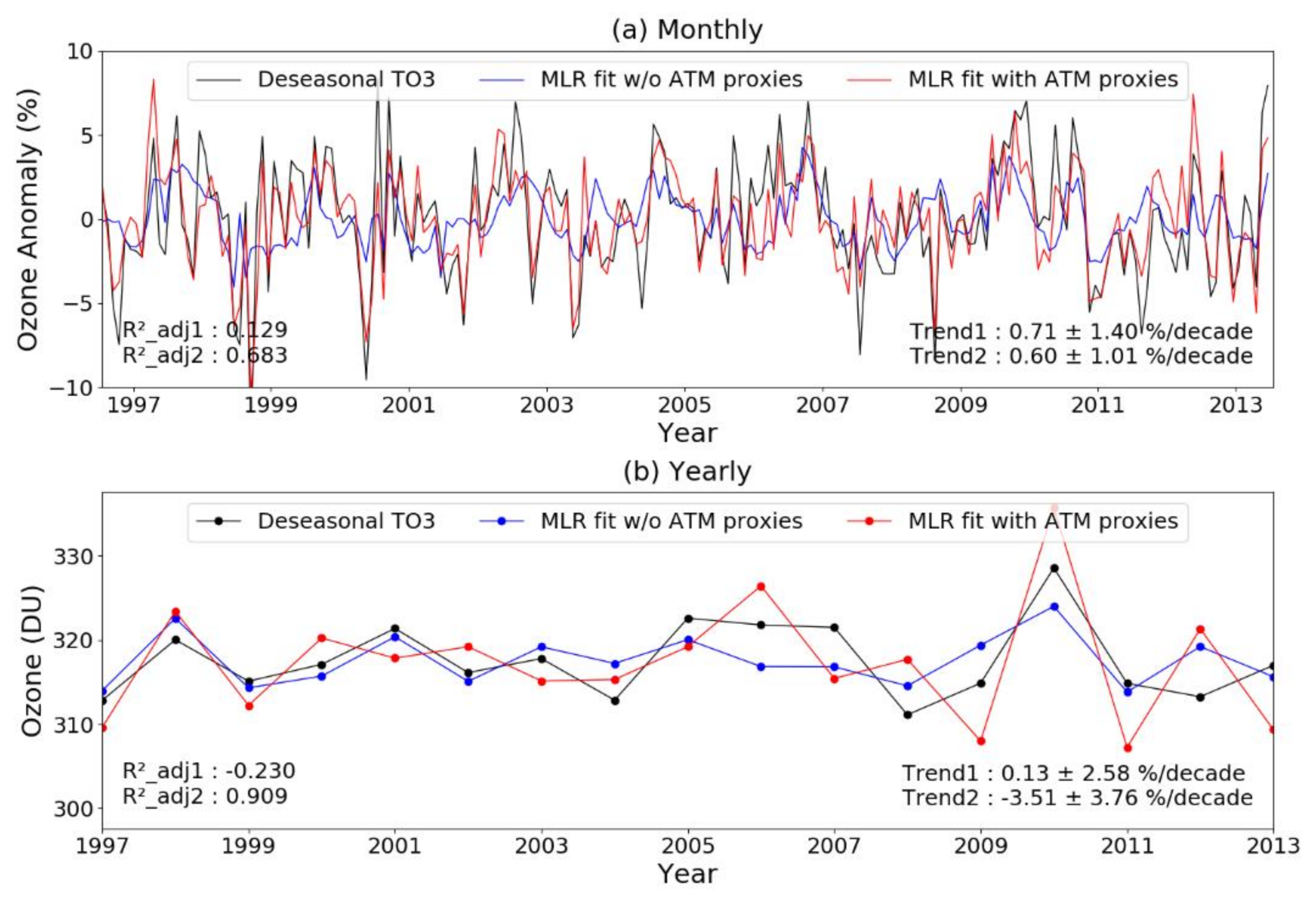
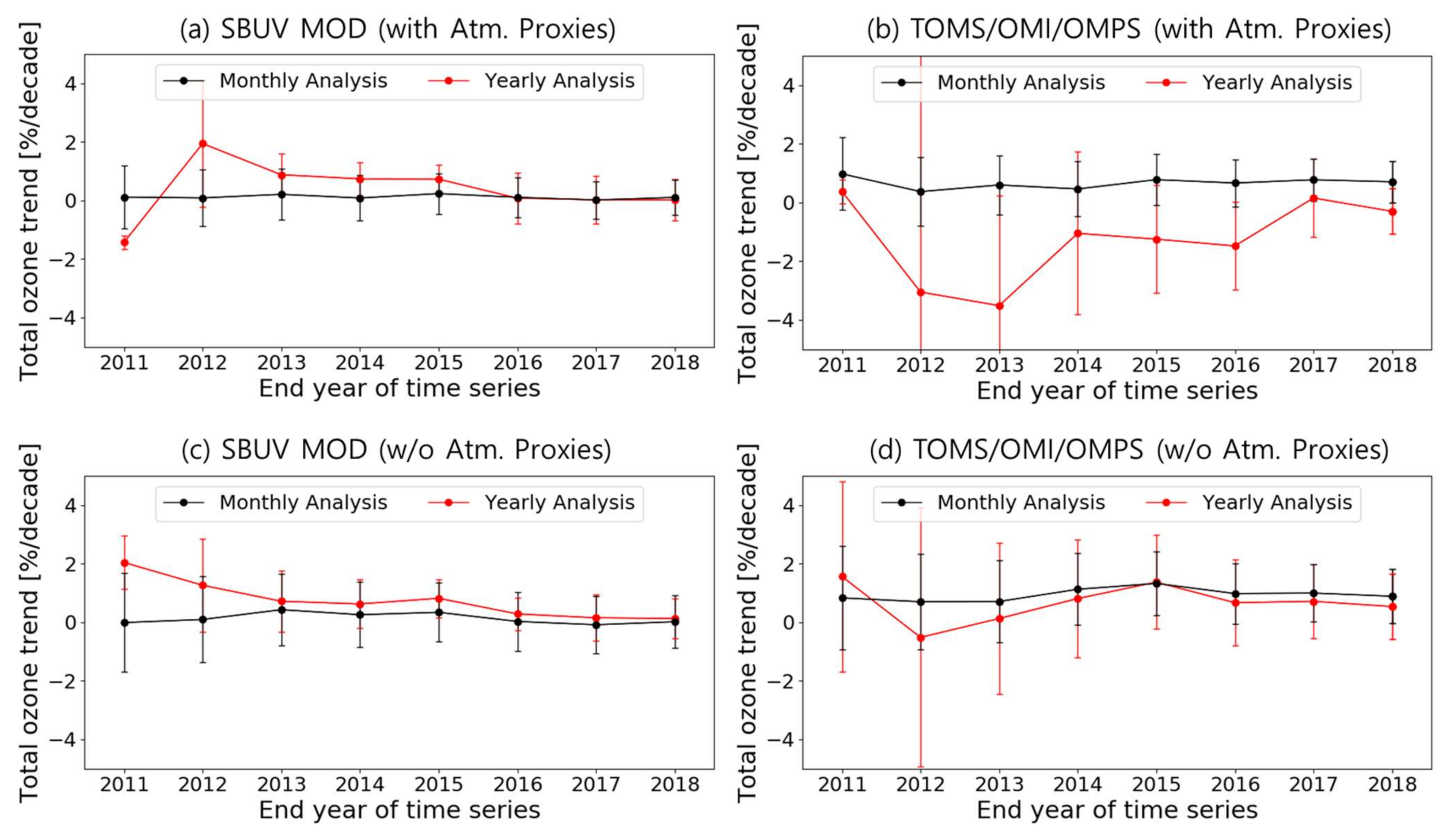
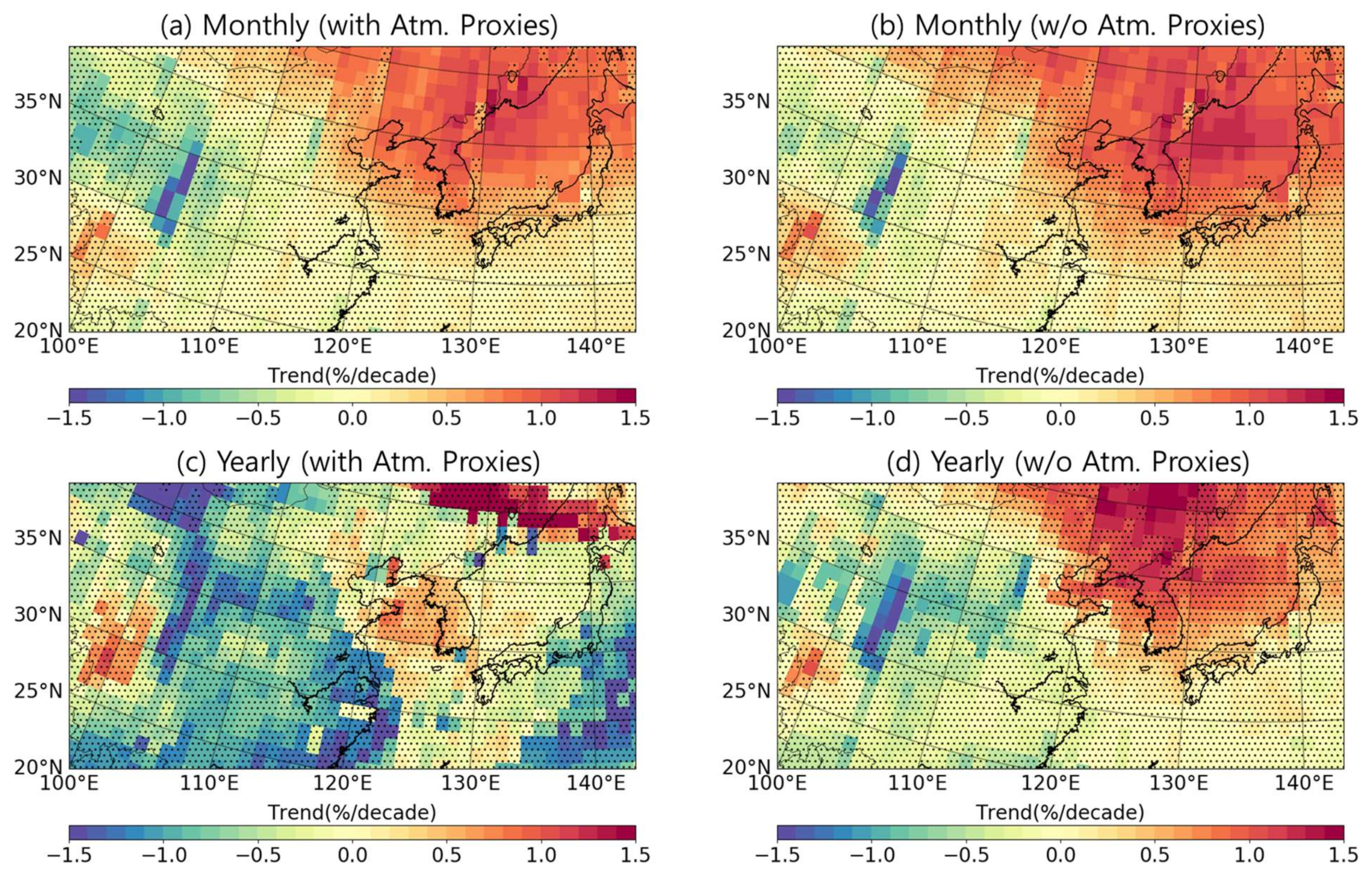
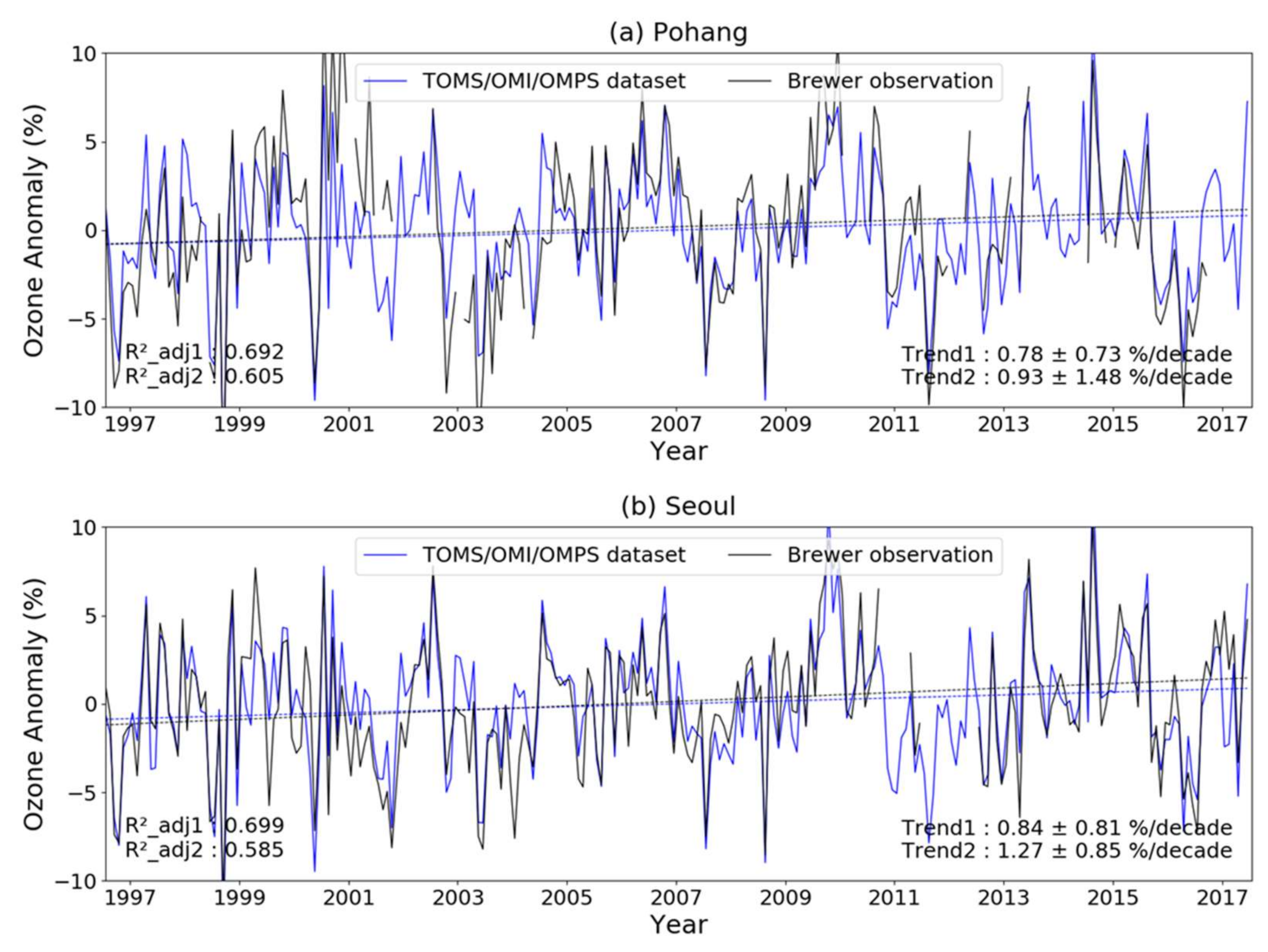
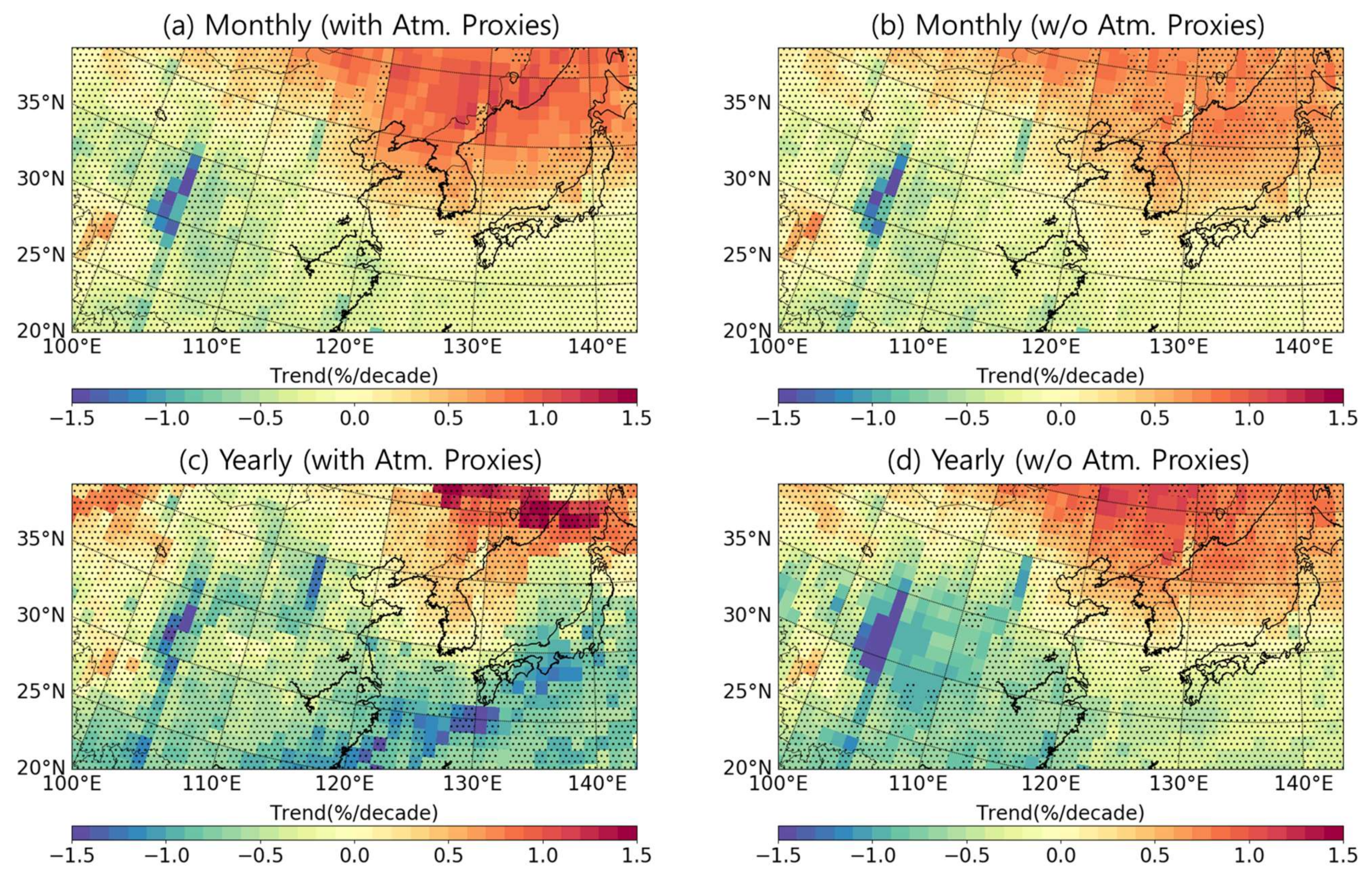
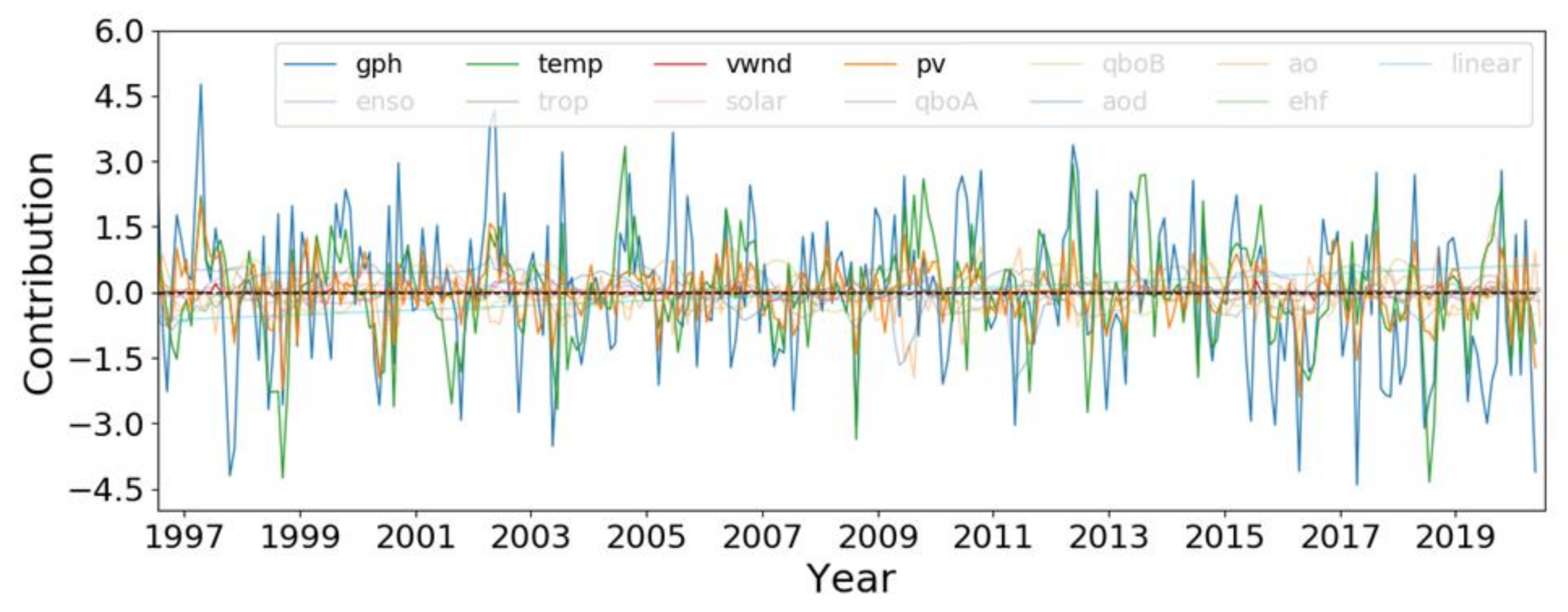
| Proxy | Parameter | Data Sources |
|---|---|---|
| Solar cycle | 10.7 cm solar radio flux | NOAA National Centers for Environmental Information: https://www.ngdc.noaa.gov/stp/solar/flux.html, accessed on 3 December 2020. National Research Council Canada Dominion Radio Astrophysical Observatory: https://spaceweather.gc.ca/forecast-prevision/solar-solaire/solarflux/sx-5-en.php, accessed on 23 October 2020. |
| QBO | EOF1 and EOF2 | Free University of Berlin: https://www.geo.fu-erlin.de/en/met/ag/strat/produkte/qbo/, accessed on 12 January 2021. |
| ENSO | Multivariate ENSO index | NOAA Physical Sciences Laboratory: https://psl.noaa.gov/enso/mei/, accessed on 22 March 2021. |
| AOD | Mean aerosol optical depth at 550 nm | NASA Goddard Institute for Space Studies: https://data.giss.nasa.gov/modelforce/strataer/, accessed on 7 January 2021 |
| AO | Arctic Oscillation (AO) index | NOAA National Weather Service Climate Prediction Center: https://www.cpc.ncep.noaa.gov/products/precip/CWlink/daily_ao_index/ao.shtml, accessed on 16 February 2021. |
| Tropopause Height | Tropopause pressure (TP) | NOAA Physical Sciences Laboratory: https://psl.noaa.gov/data/gridded/data.ncep.reanalysis.derived.html, accessed on 15 December 2020. |
| Eddy heat flux | Eddy heat flux (EHF) at 100 hPa | Calculated from ECMWF-ERA5 data: https://www.ecmwf.int/en/forecasts/datasets/reanalysis-datasets/era5/, accessed on 19 January 2021. |
| Experiment Name | Time Interval of Data | R2_adj | Trend and Uncertainty (%/Decade) | Linear Trend Type and Period |
|---|---|---|---|---|
| Pre-1997 | ||||
| MLR_ent_year | Yearly | 0.574 | −2.97 ± 1.44 | ILT for the entire period |
| MLR_pre_year | Yearly | 0.954 | −2.81 ± 0.60 | SLT for pre-1997 |
| MLR_ent_mon | Monthly | 0.136 | −2.71 ± 1.62 | ILT for the entire period |
| MLR_pre_mon | Monthly | 0.169 | −2.78 ± 1.57 | SLT for pre-1997 |
| Post-1997 | ||||
| MLR_ent_year | Yearly | 0.574 | 0.41 ± 1.45 | ILT for the entire period |
| MLR_post_year | Yearly | 0.419 | 0.72 ± 1.04 | SLT for post-1997 |
| MLR_ent_mon | Monthly | 0.136 | 0.58 ± 1.60 | ILT for the entire period |
| MLR_post_mon | Monthly | 0.167 | 0.43 ± 1.23 | SLT for post-1997 |
Publisher’s Note: MDPI stays neutral with regard to jurisdictional claims in published maps and institutional affiliations. |
© 2021 by the authors. Licensee MDPI, Basel, Switzerland. This article is an open access article distributed under the terms and conditions of the Creative Commons Attribution (CC BY) license (https://creativecommons.org/licenses/by/4.0/).
Share and Cite
Shin, D.; Oh, Y.-S.; Seo, W.; Chung, C.-Y.; Koo, J.-H. Total Ozone Trends in East Asia from Long-Term Satellite and Ground Observations. Atmosphere 2021, 12, 982. https://doi.org/10.3390/atmos12080982
Shin D, Oh Y-S, Seo W, Chung C-Y, Koo J-H. Total Ozone Trends in East Asia from Long-Term Satellite and Ground Observations. Atmosphere. 2021; 12(8):982. https://doi.org/10.3390/atmos12080982
Chicago/Turabian StyleShin, Daegeun, Young-Suk Oh, Wonick Seo, Chu-Yong Chung, and Ja-Ho Koo. 2021. "Total Ozone Trends in East Asia from Long-Term Satellite and Ground Observations" Atmosphere 12, no. 8: 982. https://doi.org/10.3390/atmos12080982
APA StyleShin, D., Oh, Y.-S., Seo, W., Chung, C.-Y., & Koo, J.-H. (2021). Total Ozone Trends in East Asia from Long-Term Satellite and Ground Observations. Atmosphere, 12(8), 982. https://doi.org/10.3390/atmos12080982







